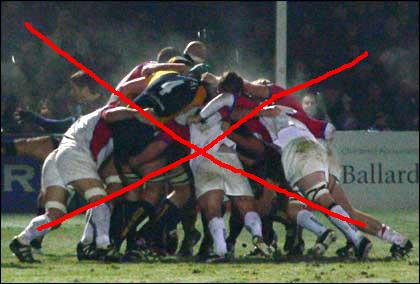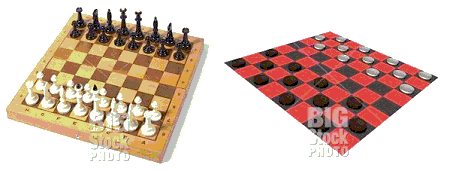Monday, May 5th, 2008
ELVs – Endangered Species: Maul and Lineout
The grave yard of rugby union.
RIP – Forward Rucking
RIP – Scrum Push Over Tries
Soon there could be the ‘maul’ and ‘full lineout’ added to the grave yard.
THE MAUL – Possible death by ignorance.
Here are some comments by NZ and AUS journos on the ELVs concerning the maul. (Note: For the record I am a kiwi). They really dont like it, ouch !
Source – The Australian (Wayne Smith – Rugby Editor) : England bores come crashing down
…”The rolling maul is an element of the game so totally at odds with every other element, so anti-rugby in its affront to the concept that the game is a contest for the ball that naturally England had to excel at it. And now that the IRB has introduced an law allowing the defending side to do what it should always have been allowed to do – tackle the blockers and bring the whole thing crashing down, England is crying foul.
No longer will England be able to kick into the corner, win the lineout and then rumble over from the maul. What a tragic loss to the game.
England’s best counter-argument is that allowing teams to collapse the maul will result in serious injury. Strange that. Teams have been collapsing mauls, illegally if morally correctly, for as long as they have been blighting the game. (How else do you think George Gregan stopped that monster in Melbourne?)
No-one has banned the rolling maul, remember. Nor has it been depowered. The IRB simply has given the defending side some power to stop it. “…
Source – Sunday Star Times (Grant Fox) – ELVs decision could be rugby landmark
..”I’m also heartened that from August teams can collapse a maul. I’m not against mauls because they are fundamental to rugby. But done properly they are incredibly hard to defend against.Therefore the attacking team has held an undue advantage.
Now there’s a legitimate tool a defending team can use to stop a maul. I’d like to think that will lead to more creative play in peeling off a maul, something the IRB might have been helped by going a step further and allowing a “truck and trailer” variation involving a minimum three players.”…
Source – www.rugbyheaven.com.au (Steve Tew – CEO NZRU ): Sanzar in new debate on ELVs
..”Tew admitted New Zealand were surprised that the dragging down of the maul had been approved, “because we weren’t convinced that all the safety elements of that exercise had been thought through”…
..”All of us are a little nervous. But kicking into the corner and scoring a try from a rolling maul after a lineout wasn’t doing the game much good … so maybe it’s a good thing.”..
MY COMMENTS
The current situation (pre ELVs) is for the defending team to the halt the momentum of the maul for a period of time to action the ‘use it or loose it rule’. If the defending team wishes to be very effective in stopping the rolling maul they must allocate the appropriate number of forwards, the more quickly this happens the less ground is lost. This attack and defense balance has worked extremely well, so if it’s not broke why fix it, yes, you guess its not pretty rugby TV!
I remember when the (‘loose it or use it’) rule was announced all the local New Zealand and Australian TV commentators thought this was a great idea, and lived happy ever after, and all of sudden it’s the black death, give me a break !
Pulling down a maul (pre ELVs) has been judged as unsafe play, the danger can be related to that of a collapsed scrum. Big men falling down on top of others powered by forward momentum. I submit that this dangerous, making this legal (across all age groups) is just STUPID! If a collapsed scrum is deemed unsafe, then how can a collapsed maul be considered safe?
A maul may have five to eight forwards from the attacking side, to pull down the maul it would only require one very strong forward, while the remaining defending forwards can stand in the ‘field wide defensive trench’. A positive attribute of the maul is that it pulls in these forwards allowing an attack out wide thru the space created. There should be less debate about the maul and more debate about how an attacking side can break down the ‘field wide defensive trench’.
The maul has a place in rugby union, it is unique to the game, I have been in a few, they are physically very tough, a real mans challenge of might over right, the mighty Richard Loe was one of the all time greats of this skill, and it should remain as part of the game.
Currently mauls in super rugby and Air New Zealand Cup are very infrequent, there is the penalty (or free kick) risk from ‘truck and trailer’ and ‘entry outside the gate’, if the defending team was allowed to pull down the maul I am very confident that mauls would be deleted from the rugby playing tactic sheet forever ! You dont need a trial for this, its a slam dunk, the maul will be extinct.
I personally have put the proposal forward that mauls should be promoted in the current super rugby ELVs as a priority form of attack. By having a rule to ensure the defending team players (not defending the maul and not the half back) be 5 meters further back. This would make the rolling maul very expensive to be allowed to continue, ensuring that the defending team would immediately commit forwards to its defense, further breaking down the field wide defensive trench for space out wide to attack. (See post ELVs (Experiment Law Variation) – Tactic Review )
An arguement for pulling the maul down is that it is impossible to defend against it 5 meters out from the try line (Steve Tew above ..”All of us are a little nervous. But kicking into the corner and scoring a try from a rolling maul after a lineout wasn’t doing the game much good … so maybe it’s a good thing.”.). If this is the case then only allow the maul to be pulled down 10 meters out from a try line. There is no need to destroy its other benefits just for this small part of the game. I would not agree to this for the reasons above, but if there is a need to compromise that’s as far as I would go.
THE LINEOUT – Possible death by stealth.
The fundamental change in the lineout is that neither side determines the numbers of the lineout.
MY COMMENTS:
At the moment the scrum and the full lineout are the only occasions between scoring where rugby has forwards and backs completely separated. The need to promote the separation of forwards and backs is critical to the development of the skill of the rugby player (chess piece) to create winning and exciting tactics (chess tactics – discovered attack). (see foundation post Chess vs Checkers)
The original intention of the short line out was to open the door for more tactical imagination into this part of the game, yes that did come, but at the expense of creating a stand off in the back line as space for attack diminished.
With the advent of the ELVs we have see the increase in the ruck to ruck phase play with the by product being the more frequent occurrence of the field wide defensive trench. I have called this non structured play and the pendulum has swung to far this way, which is why I have called for the removal of short lineouts. This would allow forwards to be forwards and backs to be backs at two fundamental restarts (scrum and full lineout).
To Conclude.
Under the new ELVs the maul is a hairs breath from extinction. The lineout is surrounded by unruly poaches that in time will finish it off. The ‘field wide defensive trench’ has gained a friend with the new maul and lineout ELVs, and that is sad for rugby union.
UPDATE1:
Source: Six Nations to be testing ground for law changes – Chris Hewett
But there is deep concern over measures affecting line-out and maul. Coaches and players spend months perfecting routines in these areas. If they end up being devalued, as many fear, two of the game’s defining characteristics will slowly fade from view.
In a survey carried out by the Rugby Football Union, around 80 per cent of those replying were against the idea that a maul could be pulled down deliberately, and something in the region of 70 per cent objected to the more radical alterations to line-out regulations. This was not the riposte of a disgruntled minority, either. As of Wednesday, there had been more than 13,000 respondents – an unprecedented number, according to the survey organisers, and proof positive that the union game matters deeply to people who live their sporting lives way outside the IRB bubble.



